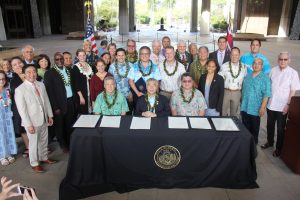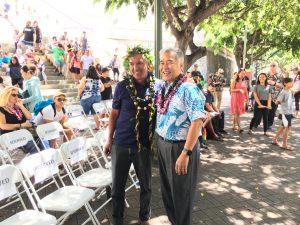Taking action statewide for a Sustainable Hawai’i
Posted on Apr 25, 2019 in Capitol Connection, Featured, MainFor sustainability, the phrase “Think global, act local” has come to mean more with each year of the Ige administration. It means growing more of our own food, focusing on clean energy solutions and nurturing a new generation committed to protecting our islands and island Earth from climate change. Hawai‘i’s leadership has been recognized worldwide for its commitment to sustainable values and practices. This issue highlights some of the progress being made as we transform aspirations into action.

GLOBAL GOALS, LOCAL ACTION: Gov. Ige joined House speaker Scott Saiki, Senate president Ron Kouchi and other community leaders April 18 at the Capitol to celebrate the state as a United Nations partner.
Q. Hawai‘i has drawn global attention for its leadership on sustainability. Why did you make this a priority of your administration?
A. Sustainability is more than what is good for the environment. It’s fundamental to changing the economy of the state, to stop exporting resources and invest more in creating jobs here in the islands. It means incorporating new technology, but also embracing traditional cultural values. We can learn from thriving Hawaiian communities of the past who were sustainable and self-sufficient, and update those practices for today.
Q. Why is the designation of Hawai‘i as a United Nations Local 2030 hub so important?
A. We should all be proud because the designation recognizes the work we’ve done through our collective efforts, Hawai‘i Green Growth, and the Aloha+ Challenge as well as the worldwide Mālama Honua voyage of the Hōkūleʻa. The models we develop in the islands of the Pacific can be models for the world. We’re tracking statewide progress through the Aloha+ Challenge Dashboard and holding ourselves accountable. This reinforces Hawai‘i as a major player in the sustainability and climate change discussion.
Q. What do you want people to know about progress on the Sustainable Hawai‘i plan? Why is it important to set ambitious goals?
A. The goals are valuable because we want to ensure that the decisions we make today advance us to long-term goals, such as 100 percent clean, renewable energy. We know we can’t save the planet by ourselves, but having these goals allows us to elevate the issues and talk on a national and global level to recognize that climate change is real so we can take action together. As the chair of the Western Governors Association, I’ve made biosecurity a focus because it’s an issue for all our states.
Q. Why is the new GEM$ on-bill initiative by the Hawai‘i Green Infrastructure Authority significant?
A. The GEM$ program is a way to reach everyone in our community, especially renters and others who couldn’t afford to install more expensive, energy-saving measures. It helps people support our clean energy goals while also reducing their electricity bill.
Q. What signs of progress are you seeing in increasing local agriculture?
A. We have businesses who have heard about our commitment to doubling local food production and are interested in making significant investments here. The whole farm-to-school ‘Aina Pono initiative in the public schools has done a great job of incorporating more local products. There’s a real commitment by everyone to seeing how we can better coordinate local farm production. Projects such as the Whitmore Food Hub can help many smaller farmers.
